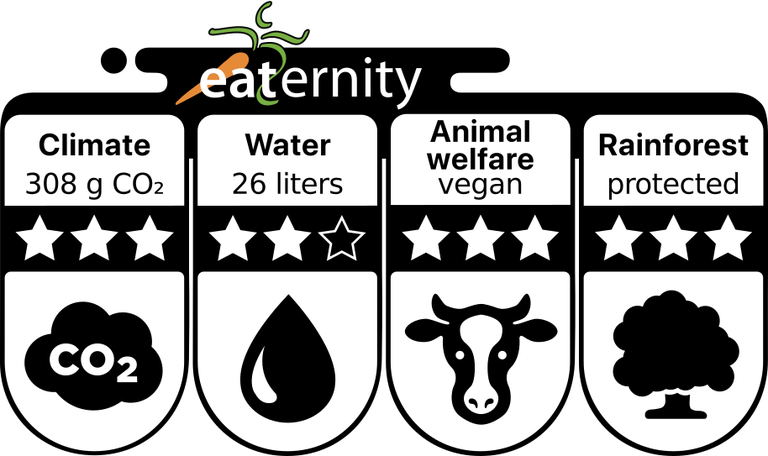The food is healthy. It says so on the package!
Logos and labels with health claims on the front of the package have been introduced to help buyers make healthier decisions. People also care more and more about eating healthy food and food producers know that too.
Consumers do react positively to health and nutrient content claims.
What are nutrient and health claims?
Nutrient content claims describe the amount of a nutrient in a food. A good source of iron is an example of a nutrient content claim.
And they know better than you that the package, and what is presented on the package sell. More specifically, the front side of the package.
But there are also other claims developed by the producers to make their food more appealing to the buyers.
General claims can make you think you are buying a healthy food without giving you a specific benefit:
- “healthy for you”
- “Good for you”
- “Detox”
- “Wholesome”
- “Nutritious”
- “For a great start to the day!”
- “A proper breakfast”
- “Natural”
- “Fit/Fitness”

Buying healthy food makes people feel good about their purchasing decisions and willing to spend and eat more of it.
Previous research funded by safefood found that, in an experimental setting, adults perceived foods with claims such as “lower in fat” to be healthier and therefore a reason to eat a bigger portion, even though, unknown to most participants, the standard version and the “lower in fat” versions of the products contained the same number of calories.
Take home message:
Health and nutrition claims on the front of the package were designed to help buyers make healthier decisions. But some food producers use claims such as high-protein to make you buy their food.
For example, yogurt can be labeled as high protein, or a source of protein, but it does not necessarily mean it is better or healthier than cottage cheese that contains the same or higher amount of protein naturally.
Is organic food healthier?
Food quality plays an important role in our health. Where the food is produced and how it is processed impact its effect on your health.
Just because the food is labeled ‘organic’ does not make it healthy. You can get organic corn syrup or potato chips.
Food & Pesticides
In conventional farming, pesticides and herbicides are sprayed on plants to kill weeds, fungi, and pests.
They are also used to quickly dry grains, which might be one of the causes of IBS, allergies, sensitivity to different foods, and why some people experience brain fog or negative reactions to grains. Gluten, should you avoid it?
Pesticides can cause health problems such as birth defects, nerve damage, and cancer. These pesticides have long environmental half-lives and can accumulate in humans and other animals and thus biomagnify up to 70,000 times in the food chain.
A study from 2006 assessed pesticide residue in grains and rice and they concluded, that conventional farming produced more wheat and rice to satisfy the market demand, but it is at the cost of health risks and poses hazards to flora and fauna.
Research has demonstrated that organic fruits and vegetables have smaller amounts of pesticide residue than produce that was grown conventionally.
For example foods on the dirty dozen* list are sprayed heavily and you should avoid buying those, unless organically produced.
The list from 2019 includes spinach, strawberries, kale, nectarines, apples, grapes, peaches, cherries, pears, potatoes, celery, and tomatoes.
But buying organic oranges or conventionally grown does not make much difference. Even if they are sprayed with pesticides and herbicides, most of it is on the peel, which you don’t consume. besides that, all the studies showing the health benefits of fruit and vegetables were done on conventional food, not organic.
What conventionally produced food is safer to eat?
Similar to the dirty dozen, there is also a list of clean fifteen* foods. It includes avocados, sweet corn, pineapple, frozen sweet peas, onion, papayas, kiwi, asparagus, eggplants, cabbages, cauliflower, broccoli, mushrooms, cantaloupe, and honeydew melon.
I’d also include legumes and grains* (there are regions where those are sprayed heavily like some states of the USA), potatoes, fruit with thick skin, dairy*, small fish, and algae.
* “The guide is based on results of more than 40,900 samples of produce tested by the U.S. Department of Agriculture and the Food and Drug Administration.”, therefore it does not reflect European or Australian produce and farming practices.
Does organic food contain more minerals and vitamins or does it taste better?
There have been studies done comparing organic and conventional produce. They compared their nutritional value, and price and even tested for taste differences. They found no significant differences in their nutritional value and taste differences depended on the food.
Some research has found higher levels of phenolic compounds and certain vitamins in organic produce. Other research has found no significant difference in the nutritional quality of organic and conventionally grown foods.
While I propose eating organic produce I also pay attention to price like many of you. The easy way out is to buy local, in-season produce from your farmers.
Make sure to wash your conventional produce thoroughly!
Manufacturers know that “organic” is a shortcut people use when searching out healthy food but keep in mind that even organic unhealthy food is still unhealthy food. In some cases, organic foods may have higher levels of nutrients than their conventional counterparts.
If you are currently consuming little fruit and vegetables, it is not worth considering, which is better. Start eating more fruits and veggies! All the health-promoting benefits associated with vegetables and fruits were discovered in conventionally grown produce. Despite their higher content of pesticide residues, the overall health effect is positive.
Eating healthy is cheap when you stick with these basics
As discussed above, labels such as organic, bio, and nice packaging also come at a premium price.
If you buy food at a farmer’s market, you can easily get premium organic produce, without a nice package, for fraction of the price. There are plenty of affordable foods you can purchase that are healthy and easy to add to your diet.
As long as you stick with traditional products, you get healthy and affordable food.
Here are some foods that are healthy & cheap:
- Grains: whole wheat, barley, oats, buckwheat, millet, spelt, rye, pasta
- Legumes: lentils, beans, chickpeas, even canned legumes
- Vegetables: kale, broccoli, spinach, chinese cabbage, red/yellow cabbage, sweet peas, carrot
- Tubers: different varieties of potatoes
- Dairy: cottage cheese, milk
- Frozen goods: sweet peas, corn, green beans, vegetable mixes, frozen kale, frozen spinach cubes, fish
- portobello mushrooms
- Eggs
- Sprouts – nutritional powerhouses anyone can grow at home fast and cheap
Cook at home
Be Smart
We’re cooking like our great-grandparents did. They lived through the Depression, wars, famines, and other challenges… what were their secrets for feeding a family in uncertain and difficult times? (Hint: Potatoes, dried beans, grains, root vegetables…) – Coalition of Health and Fitness Leaders
Best nutrition bang for your buck
-
lentils,
-
different beans,
-
peas frozen,
-
protein powder,
-
liver,
-
vegemite,
-
sardines,
-
frozen spinach,
-
cauliflower,
-
white mushrooms,
-
egg,
-
broccoli,
- watercress,
Action step:

I just threw cooked chickpeas, diced tofu, spices, mushrooms, and simmered on the pan, then squished some chickpeas with a fork to thicken it, added fresh arugula, tomatoes, and a half of a small avocado. Sprinkled over with salt, ground pepper, tabasco, lemon juice and served on the pan.
P.S. Price per portion costs me 2.04€. this will depend on where you shop but it should be cheap in most parts of the world.
Resources:
Ikonen, I., Sotgiu, F., Aydinli, A. et al. Consumer effects of front-of-package nutrition labeling: an interdisciplinary meta-analysis. J. of the Acad. Mark. Sci. 48, 360–383 (2020). https://doi.org/10.1007/s11747-019-00663-9
https://www.asa.org.uk/advice-online/food-general-health-claims.html
https://www.safefood.net/research-reports/nutrition-health
(2002) Pesticide residues in conventional, integrated pest management (IPM)-grown and organic foods: insights from three US data sets, Food Additives & Contaminants, 19:5, 427-446, DOI: 10.1080/02652030110113799
